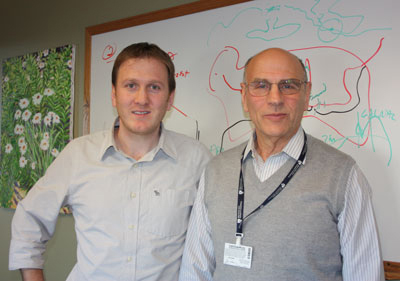Super Vaccine of the Future: The More Carbs the Better

Fikri Avci and Dennis Kasper |
Every year, we vaccinate people to protect against disease. However,
even with our best intentions, protection from pathogens is not
guaranteed. Sometimes a vaccine that may protect one population may fail
to be effective in another. But BWH researchers are on the path to
creating a new generation of more potent vaccines.
Fikri Avci, PhD, instructor in the Department of Medicine at BWH and
Harvard Medical School, and Dennis L. Kasper, MD, director of the
Channing Laboratory at BWH, in collaboration with two Rockefeller
University scientists, have developed a glycoconjugate vaccine prototype
50 to 100 times more effective than the traditional glycoconjugate
vaccine. Comprised of carbohydrate and protein molecules, a
glycoconjugate vaccine is the standard design for many vaccines used to
protect against common diseases like pneumonia and meningitis. Their
work is published in the December 2011 issue of Nature Medicine.
Researchers designed the vaccine prototype after discovering that
immune cells, called T-cells, can recognize a vaccine’s carbohydrates,
and from that recognition elicit an immune response. This discovery
challenges popular assumptions that immune cells only recognize the
protein portion of glycoconjugate vaccines.
“The immunologists knew it was only the peptides (proteins) that were
recognized by the T-cells,” said Fikri. “So then they extrapolated this
idea in the context of glycoconjugate vaccines.”
Proof in the Sugar
Proof that T-cells recognize carbohydrates came when researchers
immunized mice with different types of glycoconjugate vaccines against
the bacteria, group B Streptococcus. One group was immunized with
vaccines containing different proteins. Another group was immunized with
vaccines with the same proteins. For both groups, the carbohydrate
chain in the vaccines was the same.
Researchers saw that mice given the vaccines with different proteins
had just as good an immune response as those given vaccines with the
same proteins—the variability in proteins did not change immune
response. This told researchers that T-cells must have been recognizing
other molecules to generate a consistent immune response. They had come
upon a type of T-cell that recognized carbohydrates.
“One thing that is tremendously novel here is that we were able to
find T-cells within a mouse after immunization with a glycoconjugate
[vaccine] that just recognized carbohydrates,” said Kasper. “So these
may be the first true carbohydrate-specific T-cells found.”
In addition, the research community also assumed that after breaking
down a vaccine, the immune system disregarded the carbohydrates and only
processed the proteins to generate an immune response. Avci and
colleagues showed that this was not the case. Rather, when B-cells
(another type of immune cell) broke down the vaccine, the carbohydrates
were paired with the peptides (i. e., degradation product of proteins)
on the B-cell surface where they would be recognized by T-cells to
trigger the cells to make antibodies.
The Element of Design
Knowing that carbohydrates were being presented and recognized to
elicit an immune response, the next step was to design a vaccine that
would yield as many of these carbohydrate-peptide particles during the
breakdown process. The more of these particles, the greater the immune
response.
Traditional glycoconjugate vaccines usually yield only one to two
carbohydrate-peptide particles after they are broken down by B-cells. To
better understand why, consider proteins in traditional vaccines as
bulky blob shapes, and carbohydrates as long chains. Laying the chain
along a row of blob-shaped proteins, there are only a few points where
the carbohydrate chain can come in contact with the protein because of
the protein’s bulky shape. When B-cells break apart the vaccine, what
results are only a few carbohydrate-peptide particles. The rest of the
vaccine is wasted.
Imagine the same carbohydrate chain lined along tinier proteins with a
more uniform shape, appearing like a string of holiday lights. With the
tinier, more uniform proteins the carbohydrates are able to come in
contact at more points. So when the vaccine is processed, the results
are more carbohydrate-peptide particles. This is the vaccine prototype
Avci and his colleagues developed, and what bested the traditional
vaccine in boosting immune response. “We think this technology can be
used to improve on the design of any vaccine,” said Kasper. “Even when
glycoconjugate vaccines are used, they are not effective in all at-risk
populations. For example, pneumococcal conjugate vaccines are good in
children, but are not effective in protecting the elderly.”
Moving Forward
Avci acknowledges that there is still a lot to learn about how the immune system responds to glycoconjugate vaccines.
“We know carbohydrates are processed and presented to T-cells, and
T-cells recognize them,” said Avci. “But the molecular interactions and
through which portion of the T-cell receptor binds to the
carbohydrate—all of these will need structural biochemistry
experiments.” For now, the findings surrounding the immune system’s
response to carbohydrates provides hope for more effective vaccines of
the future.
“Carbohydrates are among the most abundant and structurally diverse
molecules in nature,” said Avci. “They are extremely important in many
biological functions. A better understanding of carbohydrate interaction
is crucial. We are hoping that our findings will provide a framework
for production of new-generation therapeutics and preventive medicines
not only against bacterial infections, but also for cancer and viral
diseases.”

Molecules in traditional glycoconjugate vaccines appear as bulky, blob shapes. |

BWH researchers used a streamlined design resembling a string of holiday lights
to accommodate as many carbohydrate and protein molecules as possible. |